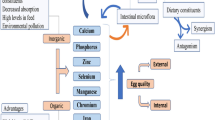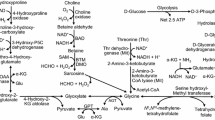Abstract
The aim of the present study was to investigate the influence of nutritional deficiency and dietary addition of vitamins (B2, B6, and folate) on hepatic concentration of zinc and copper in rats. The experiment was performed on 260 growing male Wistar rats divided into 13 groups. Animals of 11 groups were fed isocaloric diets (14.7 MJ/kg) in which the 20% of energy was derived from protein. Another two groups of rats were offered diets with 9% or 4.5% of energy originating from protein. Animals of both mentioned groups and of the control group (20% of energy from protein) were offered diets ad libitum. The other 10 groups were offered 50% and 30% of the amount consumed in the control group. Eight groups, from those 10 restricted ones, were differentiated by dietary addition of vitamins B2 and B6 and folate (300% addition). Restricted feed intake did not affect the liver zinc concentration but significantly increased the copper concentration. The addition of vitamin B6 decreased the liver Zn concentration. The highest liver Cu concentration was noted in rats offered restricted diets to only 30% of intake in the control group and high in vitamin B2 and in rats supplemented with all of studied vitamins together. It suggests that vitamin B2 had the strongest impact on liver Cu concentration in rats fed restricted diets.
Similar content being viewed by others
References
G. A. Bray, Complication of obesity, Annals Intern. Med. 103, 1052–1062 (1985).
W. B. Kanel, R. B. D’Agostino, and J. L. Goob, Effect of weight on cardiovascular disease, Am. J. Clin. Nutr. 63, 419S-422S (1996).
M. Mancini, F. Contaldo, and G. Di Biase, Frequency, relevance and reversibility of medical complications of obesity, in Medical Complications of Obesity, M. Mancini, B. Lewis, F. Contaldo, eds., Academic, London, pp. 1–23 (1979).
T. B. Van Italic, Health implication of overweight and obesity in the United States, Am. J. Clin. Nutr. 103, 983–988 (1985).
R. S. Weinstock, H. Dai, and T. A. Wadden, Diet and exercise in the treatment of obesity: effect of tree interventions on insulin resistance, Arch. Inter. Med. 158, 2477–2483 (1988).
K. V. Williams, M. L. Mullen, D. E. Kelley, et al., The effect of short periods of caloric restriction on weight loss and glycemic control in type 2 diabetes, Diabetes Care 21(1), 2–8 (1998).
R. B. Paisey, P. Harvey, S. Rice, et al., An intensive weight loss programme in established type 2 diabetes in controls: effects on weight and atherosclerosis risk factors at 1 year, Diabet. Med. 15, 73–75 (1998).
Z. Gaciag, Nowe poglady na patogeneze nadcisnienia tetniczego, Nadcisnienie Tetnicze 4, 53–58 (2000).
M. G. Simmons, J. Cox, and B. Hawlett, The effect of weight loss on the causal blood pressure of female patients whose hipertension was being treated by medication, Int. J. Obes. 23(Suppl. 5), S163 (1999).
M. Cifuentes, A. B. Morano, H. A. Chowdhury, et al., Energy restriction reduces fractional calcium absorption in mature obese and lean rats, J. Nutr. 132, 2660–2666 (2002).
S. M. Talbott, M. Cifuentes, M. G. Dunn, et al., Energy restriction reduces bone density and biomechanical properties in aged female rats, J. Nutr. 131, 2382–2387 (2001).
C. Wang, Y. Zhang, Y. Xiong, et al., Bone composition and strength of female rats subjected to different rates of weight reduction, Nutr. Res. 20, 1613–1622 (2000).
T. V. Nguyen, P. N. Sambrook, and J. A. Eisman, Bone loss, physical activity, and weight change in eldery women: the Dubbo Osteoporosis Epidemiology Study, J. Bone. Miner. Res. 13, 1458–1467 (1998).
M. V. M. Briano, D. D. Duran, and R. U. Dagach, Mineral balance during nutritional recuperation of malnourished infants, Arch. Latinoam. Nutr. 45, 172–177 (1995).
C. J. Laing and D. R. Fraser, Changes with malnutrition in the concentration of plasma vitamin D binding protein in growing rats, Br. J. Nutr. 88, 133–138 (2002).
S. E. Olpin and C. J. Bates, Lipid metabolism in riboflavin-deficient rats. 1. Effects of dietary lipids on riboflavin status and fatty acid profiles. 2. Mitochondrial fatty acid oxidation and the microsomal desaturation pathway, Br. J. Nutr. 47, 577–596 (1982).
Q. She, T. Hayakawa, and H. Tsuge, Effect of vitamin B6 deficiency on linoleic acid desaturation in the arachidonic acid biosynthesis of rat liver microsomes, Biosci. Biotech. Biochem. 58, 459–463 (1994).
P. Durand, M. Prost, and D. Blache, Pro-thrombotic effects of a folic acid deficient diet in rat platelets and macrophages related to elevated homocystine and decreased n-3-polyunsaturated fatty acids, Atherosclerosis 121, 231–243 (1996).
N. Classen, H. C. Podgieter, M. Seppa, et al., Supplemented γ-linolenic acid and eicosapentaenoic acid influence bone status in young male rats: effects on free urinary collagen crosslinks, total urinary hydroxyproline, and bone calcium content, Bone 16, 385S-392S (1995).
K. Sakaguchi, I. Morita, and S. Murota, Eicosapentaenoic acid inhibits bone loss due to ovariectomy in rats, Prostaglandins Leukotrienes Essent. Fatty Acids 50, 381–384 (1994).
H. A. Weiler, Dietary supplementation of arachidonic acid is associated with higher whole body weight and bone mineral density in growing pigs, Pediatr. Res. 47, 692–697 (2000).
H. A. Weiler and S. Fitzpatrick-Wong, Dietary long-chain polyunsaturated fatty acids minimize dexametasone-induced reductions in arachidonic acid status but not bone mineral content in piglets, Pediatr. Res. 51, 282–289 (2002).
L. Ovesen, R. Chu, and L. Howard, The influence of dietary fat on jejunostomy output in patients with severe short bowel syndrome, Am. J. Clin. Nutr. 38, 270–277 (1983).
Author information
Authors and Affiliations
Rights and permissions
About this article
Cite this article
Gralak, M.A., Bertrandt, J., Klos, A. et al. Effect of restricted feed intake and addition of vitamins B2 and B6 and folic acid on the liver concentration of zinc and copper in rats. Biol Trace Elem Res 98, 85–93 (2004). https://doi.org/10.1385/BTER:98:1:85
Received:
Revised:
Accepted:
Issue Date:
DOI: https://doi.org/10.1385/BTER:98:1:85




